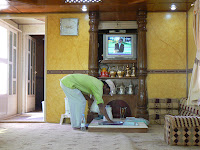.JPG) Cistanche tubulosa is a parasitic plant that grows in the desert of Northwestern Kuwait. It is related to the Orobanche, or broomrape. When I run across one, I never fail to take a look inside the flowers into which beetles are usually lodged, busy gorging temselves. It is common and most of them are already starting to wither, but I had not had a chance to take a picture of it so I volunteered to take someone else’s place on a 2-man mission to the Iraqi border. The understanding was that we’d take some time on the way back to look at flowers.
Cistanche tubulosa is a parasitic plant that grows in the desert of Northwestern Kuwait. It is related to the Orobanche, or broomrape. When I run across one, I never fail to take a look inside the flowers into which beetles are usually lodged, busy gorging temselves. It is common and most of them are already starting to wither, but I had not had a chance to take a picture of it so I volunteered to take someone else’s place on a 2-man mission to the Iraqi border. The understanding was that we’d take some time on the way back to look at flowers.It turned out that the sergeant in charge of the mission was also interested in experiencing desert life and wildlife, so we filled our morning with interesting activities. First, we stopped by some camel herders (and Indian and a Sudanese), and persuaded them to let us go for short rides on the camel that they use for herding the young ones. That was something that had been bothering me for awhile: It would be a shame to have spent a year in Kuwait without having ridden a camel at least once. So here is the obligatory picture:
.JPG)
We then went by a nomadic camel camp and spent a few fascinating hours with the owner. The owner, Bashir, is the general manager of a company in Jahra. His camel camp of about fifty camels and five South Asian employees is a hobby, but also a social setting for tribal and business relation-building. Building and maintaining relations here is crucial because Wasta (the system of “who you know and who you are related to”) factors heavily into all Kuwaiti affairs. Such a camp in the desert is called a Diwaniyah, and we were lucky enough to be cordially invited into Bashir’s Diwaniyah. Although Bashir did not speak any English and my Arabic is marginal at best, his infinite patience enabled us to talk quite a bit. Bashir is a Mutairi – a member of the numerous but not very powerful Mutayr tribe. According to Bashir, there are half a million Mutairi in Saudi Arabia, and seventy thousand in Kuwait.
Whereas most Diwaniyah consist mainly of a large tent with a few recreational v
 ehicles, Bashir’s is more functional and comfortable. His Diwaniyah is a furnished trailer that can be easily moved along with the camels, the water truck, the camel corral, a tool and camel-tending trailer, and a few employees. One of his employees is a Bangladeshi servant (I tried to think of a better word, but this one fits best). The adjoining picture is of the inside of his Diwaniyah trailer, along with his servant. We sat on the floor, using the little carpeted cubes as armrests, and drank tea and coffee while eating dates and talking. The television was on the entire time.
ehicles, Bashir’s is more functional and comfortable. His Diwaniyah is a furnished trailer that can be easily moved along with the camels, the water truck, the camel corral, a tool and camel-tending trailer, and a few employees. One of his employees is a Bangladeshi servant (I tried to think of a better word, but this one fits best). The adjoining picture is of the inside of his Diwaniyah trailer, along with his servant. We sat on the floor, using the little carpeted cubes as armrests, and drank tea and coffee while eating dates and talking. The television was on the entire time.Probably the best part of the morning came when we went out to Bashir’s herd to drink camel’s milk. One of the herders pulled a large stainless steel bowl from the Sadu (a Bedouin textile like the saddle bags in my camel riding picture) saddle bags of a riding camel and he and Bashir milked a nursing mother camel right then and there for us. Camel’s milk is delicious, with a nice froth that can be scooped out and eaten separately. Sergeant Caulum, who grew up on a dairy farm, loved the milk even more than I did; we drank a lot of it and when we were done we were completely sated.
.JPG)
The easiest way to describe the camel herd is to divide it between brown and white camels, and cows, bulls and young ones. Out of a herd of fifty two were bulls (they are kept separate, with the smaller one isolated most of the time), about twelve were born this year, and the majority was composed of cows. Most of the young camels were between one and three months old. The young camels are very friendly and fun, whereas the cows a bit aloof and the bulls almost dangerous. One thing that the handlers are always doing is exhaling through their half-closed lips so that it produces a fluttering sound that soothes the camels. Bashir really likes his camels, and his enthusiasm for them is contagious. He pets them, milks them, and even kisses them. The idea of kissing a camel sounds very strange and somewhat disgusting, but I kissed a three months old camel to see what it was like anyways. It turns out that camels have furry lips, so kissing one doesn’t at all feel like an intimate kiss. Rather, it is like kissing a teddy bear, or kissing someone on the head.

No comments:
Post a Comment